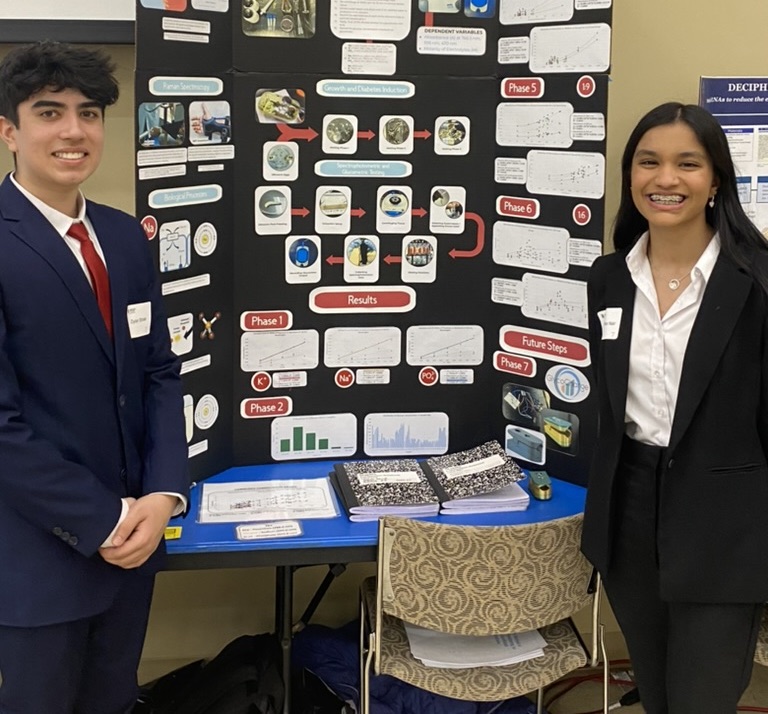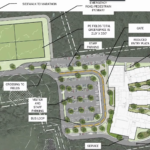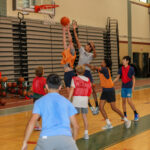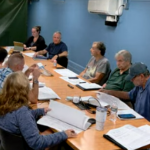
Hopkinton High School juniors Dylan Striek and Anoushka Nair display their award-winning science fair project.
Hopkinton High School juniors Dylan Striek and Anoushka Nair both have family histories of diabetes, and they recognized that glucose monitoring can be costly and inconvenient with painful, invasive blood pricks.
The duo set out to find a scientific solution to the problem. The result was their project entitled, “A Novel Spectrophotometric Approach to Non-Invasive Blood Glucose Monitoring for Type II Diabetes Mellitus Using Correlated Electrolyte Concentrations.”
The students’ efforts earned them second place at the school, regional and state science fairs. They also were named one of 300 teams nationwide — five of which were from Massachusetts — as state finalists in the 14th annual Samsung Solve for Tomorrow STEM competition, earning them a $2,500 Samsung technology prize package.
Samsung’s Solve for Tomorrow contest challenges students to create solutions to real problems using STEM (science, technology, engineering and math) skills.
Ann Woo, head of the Samsung Solve for Tomorrow competition, said she was impressed not only by the HHS students’ technical innovation, but also the “empathy” they displayed for people with the condition and their passion for the project.
In addition to the science fairs, the students presented their project at the Eureka! Fest at Massachusetts Institute of Technology and qualified to compete at the National U.S. Invention Convention in June.
“We took a different approach than others — using spectrophotometry to correlate electrolyte and glucose concentration to create a predictive model,” Striek and Nair explained in an email exchange.
They started research in June but completed experimentation from November to January after their testing model, silkworms, had grown to full size. From January to March, they worked on wiring, design and code for their biosensor product.
HHS teacher/science fair coordinator Kristen Murphy praised the pair for their diligence throughout the process, noting the students had to combine chemistry, mathematics and technology to develop the “very sophisticated” project.
She added it took the duo an “incredible” number of hours of research and work to complete.
“The kids are really committed to their ideas, and it is not a small commitment,” Murphy said.
Striek and Nair enjoyed competing at the various events, noting they liked to see other students’ projects and receive feedback from the judges.
“The best part of the project was probably running the statistical tests on our data, which showed that our model was strong and our project had yielded successful results, validating the months of hard work we had put into running experiments,” Striek and Nair noted.
On the other side, the most challenging part was the fact they had not worked with silkworms or spectrophotometry before and there is limited research on inducing diabetes and extracting hemolymph (silkworm blood).
“It took weeks of trial and error to come up with a scientifically sound and working method to collect sufficient data,” according to the students.
Murphy added that the project has the potential in the future to impact “a huge number of people.”
She said science fair projects are not all medical-related, but they are designed to tackle a particular problem.
With that in mind, a team of freshmen scientists comprised of Suhani Patni, Hasika Chauhan and Avishka Desai worked to create natural solutions for invasive species.
Patni said she noticed the increase in the tick population. Speaking with a member of the Hopkinton Open Space Conservation Commission, the students took away that global warming and having warmer weather later in the season is causing ticks to “become a huge harm.”
“This concern encouraged me to explore to see if we could find a solution to benefit our community,” Patni said.
The result was design of a tick repellant that is a non-hazardous, wearable device.
Patni said the process over several weeks involved figuring out the needed materials, finding a place to get ticks and ensuring they were safe to use, and collecting data.
The students experimented with the ticks, watching their movements and behaviors and using essential oils to make them scurry away. A hurdle was ensuring the ticks stayed alive while the students completed all data trials.
“To address this, we created humidity chambers as an environment for the ticks to live as we experimented,” Patni said.
She described participating in the science fair as “very educational, fun and motivating,” especially liking the opportunity to see “how deep” other students went in designing their projects.
Murphy noted that the district takes pride in its science fair program, thanking the HPTO and other supporters for funding equipment, chemicals and other materials that make it possible.
“The process and learning is the special part,” Murphy said.

Hopkinton High School competitors at the state science fair April 5 at Gillette Stadium pose for a group photo.
Fair winners
At the March 8 regional fair, two HHS teams earned second-place awards: “An Examination of the Neuromuscular Impact Induced By Hypermagnesemia & Hypocalcemia in Caenorhabditis Elegan Mutants: A Translational Genomic Model for Paralytic Drug Testing” by Srilakshmi Venkatesan, and “A Novel Spectrophotometric Approach to Non-Invasive Blood Glucose Monitoring for Type II Diabetes Mellitus Using Correlated Electrolyte Concentrations” by Dylan Striek and Anoushka Nair.
Taking third place was “Assessing the Feasibility of Dawsonite Production as a Carbon Sequestration Strategy” by Rylee Blair and Disha Mudenur.
Honorable mentions went to “Autonomous Algal Bloom Control via AI-Regulated Photodynamic Therapy” by Kaizar Rangwala and Pranamya Keshkamat, “Algae Fertilizer: Efficiency and Biosorption of Copper by Chlorella Vulgaris” by Juliet Findlen, and “Advanced Biosignature Detection Model For Finding Extraterrestrial Life using Capillary Electrophoresis” by Garima Chauhan.
At the April 5 state fair at Gillette Stadium in Foxborough, six of the eight HHS teams to qualify won prizes. There was a total of 270 projects competing at the fair.
Second-place awards went to Venkatesan, the teams of Nair and Striek, and the team of Keshkamat and Rangwala. Third-place awards went to Findlen and the freshman team of Shrila Maity and Jacob Wu.






















We are proud to hear a great idea put forth by students of a school. Ms. Nair is from our state of Kerala. Congratulations.